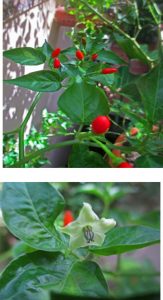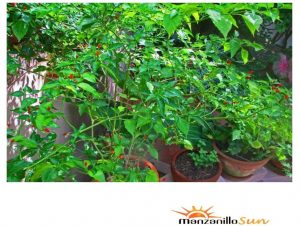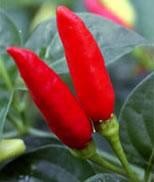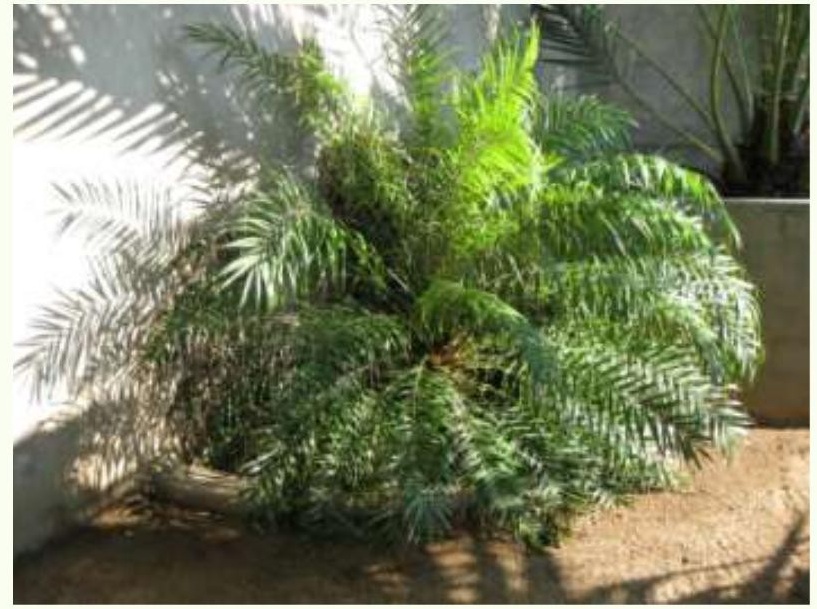By Tommy Clarkson from the October 2014 Edition

Capsicum frutescens
(or C. fastigiatum or C. annuum)
Family: Solanaceae
(Also known as Cayenne Pepper, Bird Pepper and Chili Pepper)
Patty claims that, long ago, my eating habits burned off all of my taste buds! Hence, with my proclivity for piquant, hot foods it goes without saying that I absolutely love Tabasco Sauce. (This distinctive spicy sauce, long carried by all manner of soldiers to improve their rations was first created by Edmund McIhenny in 1668 on Avery Island in Louisiana and was originally distributed in old perfume bottles!)
In fact, when Patty and I were in Louisiana, for some nine months, assisting with the rebuilding following Hurricane Katrina it was late on one Sunday afternoon that, while taking an afternoon off, I bought the seeds from whence their ancestor plants now grow in Ola Brisa Gardens (Accordingly, for more in-depth data I refer you to their site: www.tabasco.com/tabasco-products/how-itsmade/making-original-tabasco-sauce/ )
OK, right from the outset – from the Scoville Scale which is the official measurement of the pungency (or spicy heat) of peppers – let’s settle the question of just how hot Tabasco Peppers are in relation to their pepper kin.
Starting at the bottom, a Green Bell Pepper is zero. Pimentos and Pepperoncini are in the 100 to 500 range. Poblanos muddle along in the 1,000 to 1,500 area. Jalapeños (yum, yum) are but 2,500 to 8,000. Turning up the heat – so to speak – Scotch Bonnets and Habaneros burn in at 100,000 to 350,000. The famous Thai Ghost Pepper scalds around 855,000 to 1,041,427. While the Carolina Reaper (A brother-in-law, I suspect, of the Grim Reaper and which I suspect may melt titanium) is in the range of 1,400,000 to 2,200,000.
And we quibble with the paltry 30,000 to 50,000 Scoville points of the Tabasco/Cayenne Peppers. Sheesh!
The origin of these culinary gems is believed to be Central or South America.
As to the Tabasco plants themselves, they are compact, with stems growing between one and four feet (.3 – 1.2 meters) tall. Their stem grows straight up curving just before it touches the flower head. Their short, shrubby growth and large number of flowers make them ideal for containers/pots, so yes, you can have them on your patio!
Capsicum frutescens bushes often produce clusters of pods (peppers) growing just above their foliage and providing them with a rather attractive ornamental look. A single plant is capable of producing more than 100 peppers. Most are small, grow erect and are typically lanceoloid or ellipsoid-conical shaped. The flowers are white with a greenish yellow or greenish white corolla. The fruit are yellowish initially darkening as they mature turning red when ready for picking. In fact, in the Tabasco Sauce fields where they are hand-picked, a Petit Bâton Rouge, or “little red stick” is used as a guide. It is painted the color of a perfectly ripe tabasco pepper ensuring “only the ripest red peppers are picked.”
As to cultures that savor these peppers, there is an abundance of these chilies is Ethiopian cuisine as well as Egyptian and Moroccan dishes but they are, worldwide, increasingly, becoming a favorite.

Like most other pepper plants, Tabasco Peppers enjoy heat and humidity and have little tolerance to drought. They grow best in moist, well-drained (a bit sandy), fertile – kept moist – soil enriched with organic matter. If you wish to grow them outdoors choose a location where they will get full sun.
For those interested in specifics, the source of the popular biting sensation in Capsicum frutescens are the  capsaicinoids (principally capsaicin). Small, but packing culinary punch, they are an excellent source of vitamins A and C so why not pop one in your mouth every morning with your multi-vitamin. . . or not!
capsaicinoids (principally capsaicin). Small, but packing culinary punch, they are an excellent source of vitamins A and C so why not pop one in your mouth every morning with your multi-vitamin. . . or not!
Powdery coatings are used with varying degrees of success in thwarting browsing of crops by animals and insects – though I have, so far, had no luck stopping iguana with such. But, by placement on their digits, children can be broken of thumb sucking and nail biting – Gee, ya’ think! With an active ingredient of capsaicin, pepper spray (2,000,000 to 5,300.000 on the Scoville Scale), is effectively used for protection by civilians and law enforcement alike.
It has numerous medicinal applications such as a salve to relieve muscle, joint, and toothache pain and can be employed as treatment of coughs, asthma, sore throats stomach aches, seasickness, and flatulence. And in days of yore, it was even used as an instrument of torture! (Now we’re back to stopping thumb sucking!)
Download the full edition or view it online
—
Tommy Clarkson is a bit of a renaissance man. He’s lived and worked in locales as disparate as the 1.2 square mile island of Kwajalein to war-torn Iraq, from aboard he and Patty’s boat berthed out of Sea Bright, NJ to Thailand, Germany, Hawaii and Viet Nam; He’s taught classes and courses on creative writing and mass communications from the elementary grades to graduate level; He’s spoken to a wide array of meetings, conferences and assemblages on topics as varied as Buddhism, strategic marketing and tropical plants; In the latter category he and Patty’s recently book, “The Civilized Jungle” – written for the lay gardener – has been heralded as “the best tropical plant book in the last ten years”; And, according to Trip Advisor, their spectacular tropical creation – Ola Brisa Gardens – is the “Number One Tour destination in Manzanillo”.




You must be logged in to post a comment.